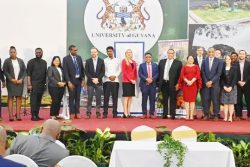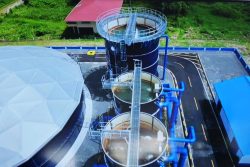Sometimes, in the everyday course of life, an interaction comes along, out of the blue, that is unusual and startling and revealing all at the same time. This past week, for example, my wife Annette and I had been asked by the folks at Wilderness Explorers (Teri and Gavin O’Brien) to do an informal cultural presentation for the passengers on the National Geographic Explorer vessel visiting Guyana. The outing turned out to be a highlight of our week.
In two days of singular experiences, the Explorer itself was a key one. Commissioned 10 years ago as part of the National Geographic Lindblad Expeditions, she is a state-of-the-art Norwegian-built vessel, 367 feet long, and the term ‘high quality’ applies everywhere. Just one week after my column stressing the importance of detail, the Explorer is classic example of doing it right. Every piece of fitting is either stainless steel or chrome, so everything looks brand new. Superior quality shows in every cabin, down to the lighting fixtures and the bathroom appointments. The ship is built with six decks, includes several spacious observation areas, and accommodates 160 passengers. The crew of 81 (that ratio in itself is informative), obviously carefully chosen, are relaxed but accomplished in their work, ranging from Patrick, who welcomed us on board, to expedition leader Bud Lehnhausen, to the technician (sorry, I’m bad with names) who handled our audio and Power Point details, to the dapper Filipino staff in the dining room.
In a complement of 11 vessels, National Geographic operates these Lindblad nature expeditions (named for the Norwegian founder of the idea) all over the world, from as far away as China and as near as Venezuela. The trips range from 10 to 34 days, all with a nature focus. On board, the ships provide Zodiac landing craft, stable sea kayaks, and snorkelling gear, as well as specially designed tools that allow for more extensive exploration. A singular feature of the adventure is the team of experts that accompanies every trip—seasoned naturalists, undersea specialists, and researchers who share their knowledge and insights with passengers. On select voyages, the complement includes a National Geographic scientist, historian, photographer, or explorer. The day before our visit, for instance, Explorer passengers were treated to a lecture on plate tectonics. National Geographic “experts on board” include naturalists who will take passengers ashore for field trips during the days, and even sometimes at night. One night trip in the Essequibo, they set out looking for bats and snakes; Annette and I passed.
 Meeting the passengers, who were clearly all lovers of nature and mostly American, was an experience, as well. They were enthralled with Annette’s presentation on the Amerindian culture, and with my more rootsy slide show and my songs and chat on Guyanese culture. Before we left the ship the next morning, the chats and the questions continued. Over breakfast, we had a particularly lovely time with an American gentleman, a retired professor from the University of Miami, who had been on 16 Lindblad trips and was planning more.
Meeting the passengers, who were clearly all lovers of nature and mostly American, was an experience, as well. They were enthralled with Annette’s presentation on the Amerindian culture, and with my more rootsy slide show and my songs and chat on Guyanese culture. Before we left the ship the next morning, the chats and the questions continued. Over breakfast, we had a particularly lovely time with an American gentleman, a retired professor from the University of Miami, who had been on 16 Lindblad trips and was planning more.
It is important to make the distinction, however, that this is not mass market cruise tourism, or the “blue water and white sand” crowd. There are no casinos, or late-night parties, or shopping frenzies on shore. We’re talking a very specific adventure tourism niche here. National Geographic and Lindblad have taken special care to create a superior product, in every sense, catering to a particular traveller with very particular interests. And, as you may have gleaned by now, these trips do not come cheap. The Lindblad tours range from US$13,000 to US$45,000 (for the longer ones) and travellers must also meet the airfare cost of getting to the departure point and back home. This Guyana visit, for instance, had started in Trinidad. It would take 38 days and visit 8 countries, skirting the South American coast, and terminating in Buenos Aires. But given that the travellers we encountered are clearly very affluent ones, the revelation is the existence of this kind of high-end tourism where persons are happy to pay large sums for a particular experience conducted in a particular way, and the people we met were having the time of their lives. Incidentally the May issue of National Geographic magazine highlights its choices of nature spots to visit in the world (‘Tours of a Lifetime’) and Guyana is one of the countries in the top 50.
The third part of the experience was to be confronted with the realization of your country’s physical potential, both for its impressive natural resources and, tangentially, as an attraction for visitors. To be on the third deck of Explorer, off Laulau Island, at 8 in the morning, and look out across the Essequibo (a mile wide at that point) is to be in a different world. In terms of size alone, never mind beauty, the river is a treasure (several of the passengers remarked on that), and given that this was just one corner of Guyana one was left with a sense of wonder that stayed with us for days.
Of course, care must be taken not to get over-enthused about the tourism prospects. This was a very specific venture, one of a kind. Impressive as it is, it’s bringing approximately 100 persons here, perhaps once a year – not exactly mass market numbers. Furthermore, as a form of self-contained cruise tourism, it does not bring to destinations the high revenues of hotel, restaurant, shopping, entertainment, and ground transport. But the Explorer visit is an instant verification of the variety that exists in the world of travel, and it can hopefully help to convince us of the possibility of managing our landscape to our own commercial benefit. Being on that ship might help us, as an example, to grasp the urgency of the “clean up Georgetown” cry coming from our wider tourism sector.
Although Annette and I donated our services for the presentation, looking back on it we both felt we had gained something of more value than money. From my side, I was thinking on the way back that save for my being a musician of some note, I would have been right here in Guyana none the wiser about this totally self-contained world that had come here and gone, under my nose. I had some fascinating conversations with some of the persons on the ship, who almost bowl you over with their interest in your country and in you, and I had seen the level of opulence that that interest ultimately generates. Always taken with the Essequibo from the Adventure ferry days, I had also seen the river in a new way, through my own sight, and through the eyes of others encountering it for the first time. All in all, an experience to remember.








